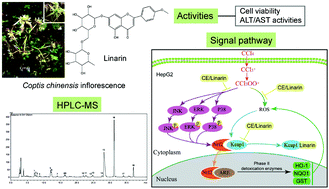Coptis chinensis inflorescence is traditionally used as tea and has been popular in the local market. C. chinensis inflorescence extract (CE) exhibits protective effects against carbon tetrachloride (CCl4)-induced damage, but the underlying mechanism remains unclear. The main chemicals of CE were detected, purified, and identified in this study. CE and linarin could reverse changes in cell viability, decrease alanine aminotransferase and aspartate transaminase levels, and reduce reactive oxygen species (ROS) generation induced by CCl4 in HepG2 cells. CE and linarin could also phosphorylate mitogen-activated protein kinases (MAPKs) and up-regulate Kelth-like ECH-associated protein (Keap1). The pathways of MAPKs and Keap1 lead to the separation of Keap1 and nuclear factor (erythroid-derived 2)-like 2 (Nrf2). Free Nrf2 transferred to the nucleus and enhanced the expression of phase II detoxification enzymes. This study provides a scientific basis for the use of C. chinensis inflorescence, which exhibits a hepatoprotective function, as a supplement in the food industry.

